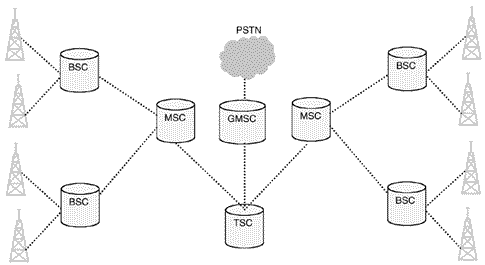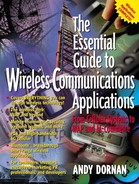Voice Infrastructure
A traditional cellular network is based on the fixed PSTN (Public Switched Telephone Network), but with some extra databases to deal with mobility. The equipment is analogous to switches, the devices at traditional telephone exchanges, which establish circuits whenever a call is made.
Mobile networks are relatively new compared to the fixed system—they date from around 1980, rather than 1900—so the switches they use tend to be more advanced. All switching is digital, even on G1 systems, which use an analog air link. All mobile phones use tone dialing, which represents digits by musical notes; none use pulse dialing, which sends a series of clicks instead and is still found on many fixed lines.
Though packet data is the hot new technology in the wireless world, the old voice infrastructure is not going away. Even when data networks are complete, many voice calls will still be sent over the existing circuit-switched infrastructure, as will new applications such as video. And until the upgrades are complete, circuit switching will be the only option for data. This is the rationale behind HSCSD, the upgrade to GSM that increases throughput by binding circuits together.
BSC
The first step in a digital cellphone network is the link from BTS to Base Station Controller (BSC). This simply converts signals from a base station to a more landline-friendly format. Analog networks need to place the BSC at the BTS itself so that the analog air link can be converted to digital signals as soon as it is received. Digital networks prefer to locate it a few kilometers away, which keeps costs down as it allows several base stations to share a BSC. It also means the complex and expensive electronics of the BSC can be kept in a safe and secure environment rather than in the open air.
The cells linked to a single BSC will often correspond to the clusters, groups of between 3 and 21 cells that together utilize all the operator's available radio spectrum, described in Chapter3, "Cellular Networks." A BSC can sometimes distribute spectrum among its BTSs dynamically, allowing more of it in a cell that contains more users. The BTS, the BSC, and the links between them are sometimes referred to collectively as the BSS (Base Station Subsystem).
MSC
The most complex component in a mobile voice network is the Mobile Switching Center (MSC). Analogous to a telephone exchange, the MSC is responsible for keeping track of users and sending them calls when necessary. A network usually contains many MSCs, each of which is responsible for several clusters of cells.
Though they don't know it, all customers of a mobile network are registered with one particular MSC, described as their home MSC. This is occasionally used for billing purposes, defining calls within that MSC's area as local, but is usually irrelevant to the end user. It is important to the network itself, as the home MSC is always contacted when trying to switch a call to the user.
Each MSC is linked to several databases, which are used to store users' locations and billing information. These can be stored on a computer at the MSC itself, though they don't have to be—because all MSCs are linked together by a fixed network, they can be located anywhere. Some MSCs use both a local database and a backup copy.
The databases are shown in Figure 8.2, and include:
The Home Location Register (HLR) contains the location of every handset registered to the MSC. Precise geographical information is stored only for users who remain within its own coverage area. If the user has moved outside, it instead stores a number identifying the MSC to which they have moved. This new MSC can be within the operator's own network or that of another operator into whose network the user is roaming.
The Visitors' Location Register (VLR) stores the geographical location of all handsets temporarily within an MSC's coverage area. When a call is made to one of these customers, their home HLR contacts the new cell's VLR, enabling the user to be located. The weakness of this system is that all calls have to be routed via a user's home HLR, which can be expensive when roaming internationally—a local call within Paris made by a customer of a British network will be routed via the UK and charged as two international calls. Many networks are now implementing a newer system called MAP (Mobile Application Part), which only looks up the HLR and VLR once, then routes calls locally if possible. This reduces costs to operators, though many still impose high roaming charges on their customers.
The Equipment Identity Register (EIR) lists unique numbers which are used to identify each handset. This allows calls to be billed correctly. It also stores the details of all phones reported stolen, so that they cannot be used.
The Authentication Center (AuC) exists only in digital networks. It ensures that a mobile subscriber is actually who she claims to be, by requesting that the identity number sent to the EIR is encrypted while transmitted over the air. The encryption key is stored in the HLR, alongside the user's location. This prevents cloning by ensuring that a pirate cannot listen into a transmission and discover a handset's identity number. The TETRA system also authenticates the network, so that criminals cannot set up a fake mobile system.
The Messaging Center handles SMS messages, routing them to and from phones. It is included as standard in GSM systems, but has to be added separately to networks based on other standards.
Figure 8.2. MSC database subsystems

TSC
In early cellular networks, all MSCs were meshed—each was connected to each other. This quickly grew uncontrollable, so Trunking Switching Centers (TSCs) became common. These simply aggregate connections from several MSCs, combining them in very high-capacity cables. Not all operators use TSCs; some simply have each MSC cover a very wide area. Where TSCs are used, a network will usually contain very few of them, or sometimes even just one.
GMSC
The Gateway Mobile Switching Center (GMSC) sits at the top of the switching hierarchy, as shown in Figure 8.3. It connects a mobile network to the fixed PSTN and to other operators with which it has roaming agreements. Networks which utilize MAP require the GMSC to have its own HLR, so that every customer can be located without having to query their home MSC.
Figure 8.3. Mobile switching hierarchy

